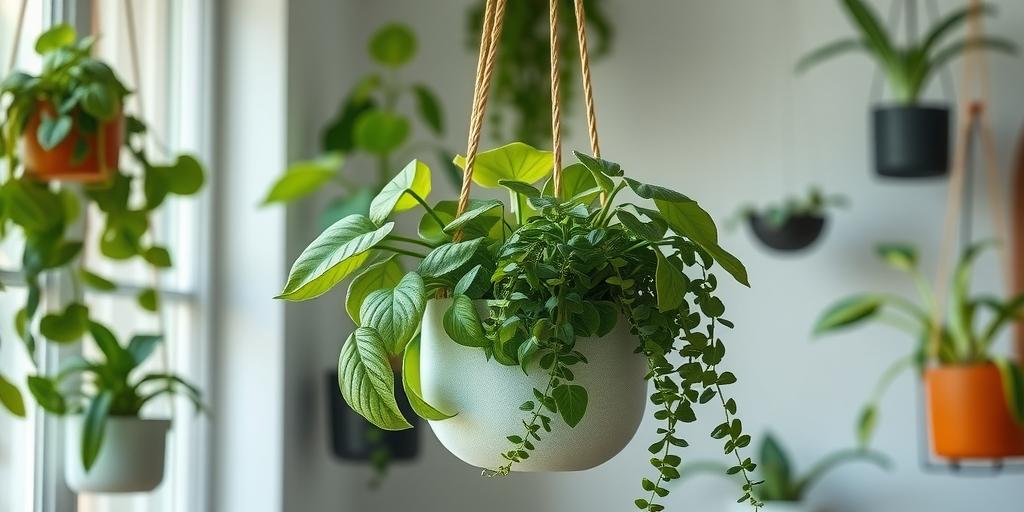
5 Drought-Tolerant Hanging Plants That Thrive in Low Light (2025)
Discover the best drought-tolerant hanging plants that survive low light conditions! Perfect for busy plant lovers, these hardy beauties add greenery to any space with minimal care.
Introduction
Did you know that some plants can survive weeks without water and thrive in dim corners? If you’ve struggled to keep hanging plants alive in low-light areas, you’re not alone. Many houseplants demand constant attention, but not these resilient varieties! Whether you’re a forgetful waterer or live in a shady apartment, these five drought-tolerant hanging plants will bring life to your space—without the fuss. Let’s dive in!
Spider Plant (Chlorophytum comosum)
Why It’s Perfect
If you’re new to houseplants or just want something low-maintenance, the spider plant is a fantastic choice. It thrives in indirect light and won’t hold a grudge if you forget to water it now and then. Plus, it’s one of the best air-purifying plants out there, removing toxins like formaldehyde and xylene from your indoor air.
Care Tips
Spider plants prefer well-draining soil, so make sure their pot has drainage holes. Water them sparingly—wait until the top inch of soil feels dry before giving them a drink. Overwatering can lead to root rot, but they’re pretty forgiving if you slip up.
Bonus Benefit
One of the coolest things about spider plants is how they produce “spiderettes”—little baby plants that dangle from the mother plant. You can snip these off and propagate them in water or soil, making it easy to expand your plant collection or share with friends.
Pro Tip
If the tips of your spider plant’s leaves turn brown, it might be due to fluoride in tap water. Try using filtered or distilled water to keep them looking lush.
String of Pearls (Senecio rowleyanus)
Why It’s Perfect
This quirky succulent is a showstopper with its trailing stems of bead-like leaves. It’s perfect for plant lovers who want something unique and visually striking. Since it stores water in its leaves, it can go longer between waterings, making it ideal for forgetful plant parents.
Care Tips
Bright, indirect light is best, but string of pearls can tolerate lower light conditions (though it may grow slower). The biggest mistake people make is overwatering—wait until the soil is completely dry before giving it a drink. When in doubt, underwater rather than overwater.
Warning
Overwatering is the quickest way to kill this plant. If the pearls start to shrivel, it’s a sign they need water, but if they turn mushy or yellow, you’ve gone too far.
Styling Idea
This plant looks amazing in hanging baskets or on high shelves where its long tendrils can cascade down. It adds a bohemian or modern touch to any space, especially when paired with macramé hangers or minimalist decor.
Pothos (Epipremnum aureum)
Why It’s Perfect
Pothos is the ultimate beginner-friendly plant—it’s nearly indestructible. It can survive in low light, withstands drought-like conditions, and still grows like a weed. If you’ve struggled with keeping plants alive before, pothos will restore your confidence.
Care Tips
Let the soil dry out between waterings—pothos prefers neglect over too much attention. It thrives in a variety of lighting conditions, from low light to bright indirect light (though variegated varieties like Marble Queen need more light to maintain their patterns).
Varieties to Try
-
Golden Pothos: Classic green leaves with yellow variegation.
-
Marble Queen: Cream and green marbled leaves.
-
Neon Pothos: Vibrant lime-green foliage.
Bonus
Pothos is incredibly easy to propagate. Just snip a stem below a node and place it in water—it’ll grow roots in no time. You can keep it in water indefinitely or transfer it to soil once the roots are established.
ZZ Plant (Zamioculcas zamiifolia)
Why It’s Perfect
The ZZ plant is practically bulletproof. It thrives in low to moderate light and can go weeks without water, thanks to its thick rhizomes that store moisture. If you’ve got a dark corner where other plants refuse to grow, the ZZ plant will happily take the spot.
Care Tips
Water it every 3-4 weeks, allowing the soil to dry out completely between waterings. It’s better to underwater than overwater, as too much moisture can cause root rot. ZZ plants aren’t picky about humidity, making them great for dry indoor environments.
Ideal For
Offices, bedrooms, or any space with limited natural light. It’s also a great choice if you travel often and can’t water your plants regularly.
Caution
While ZZ plants are tough, they are toxic to pets if ingested. If you have curious cats or dogs, place the plant on a high shelf or in a hanging planter to keep it out of reach.
Burro’s Tail (Sedum morganianum)
Why It’s Perfect
This succulent is a stunner with its long, trailing stems covered in plump, blue-green leaves. It’s perfect for adding texture and visual interest to your space, especially in hanging planters where its cascading growth can be fully appreciated.
Care Tips
Burro’s tail loves bright, indirect light but can tolerate lower light conditions (though it may grow more slowly). Water it infrequently—wait until the soil is completely dry, then give it a thorough soak. Like most succulents, it’s prone to root rot if overwatered.
Unique Feature
The trailing stems can grow several feet long, making it a dramatic addition to bookshelves or windowsills. The leaves have a delicate, almost pearl-like appearance, adding a soft, elegant touch to your decor.
Watch Out
The leaves are fragile and can easily fall off if bumped or handled roughly. If you need to move the plant, do so gently to avoid losing too many leaves. The good news? Those fallen leaves can be propagated—just place them on soil, and they’ll eventually grow into new plants!
Conclusion
Who says low-light spaces have to stay dull? With these five drought-tolerant hanging plants, you can enjoy lush greenery without constant watering or perfect sunlight. Whether you choose the cascading String of Pearls or the hardy ZZ Plant, each of these varieties brings beauty and resilience to your home. Ready to transform your space? Pick your favorite and let it thrive with minimal effort!
